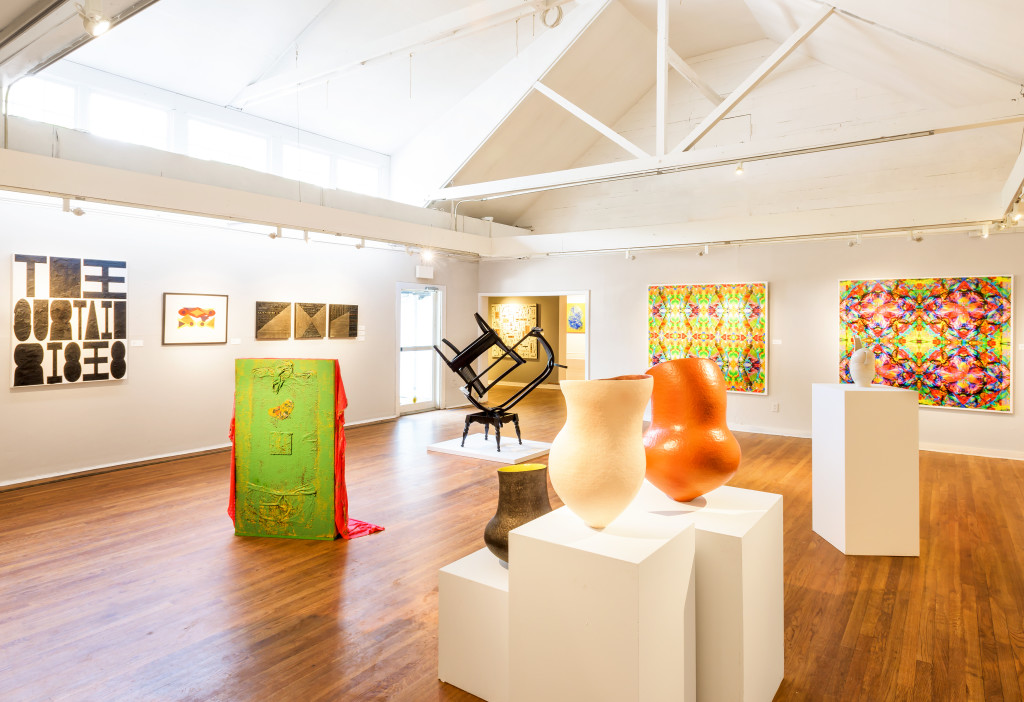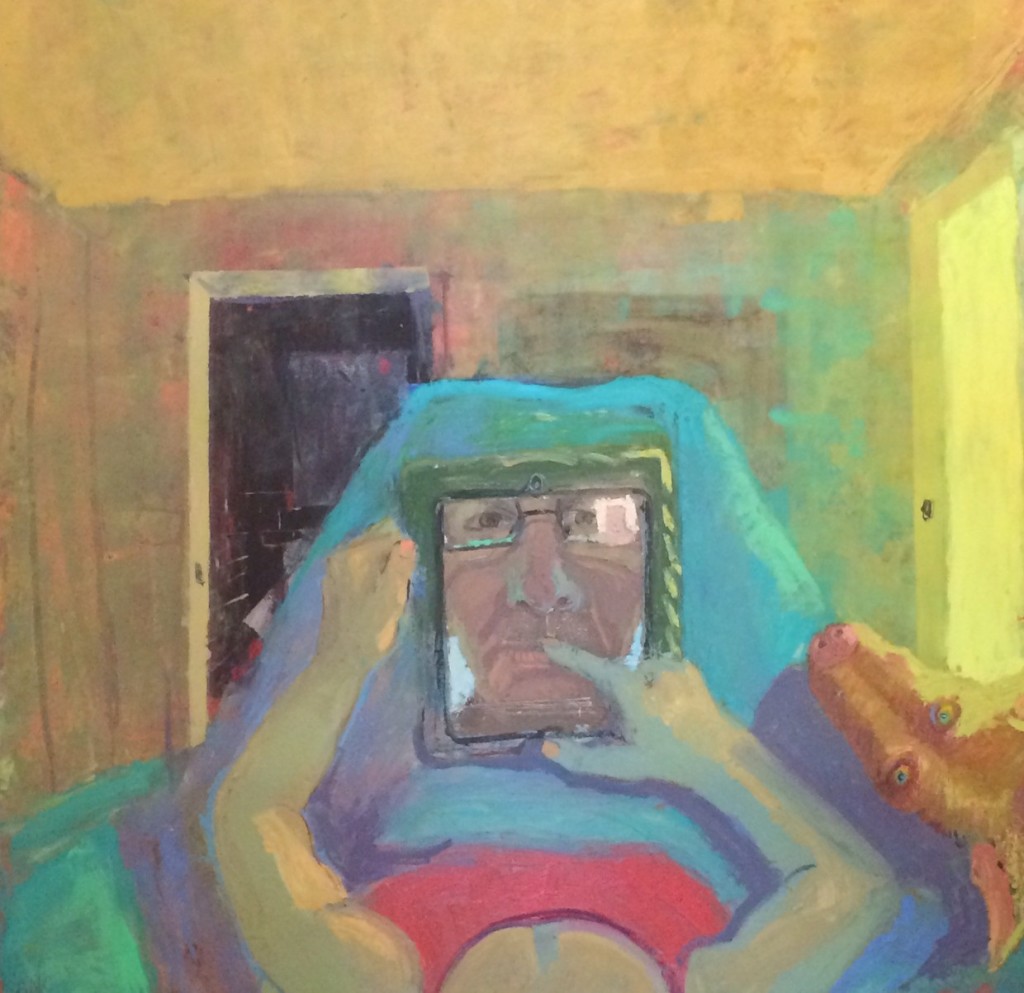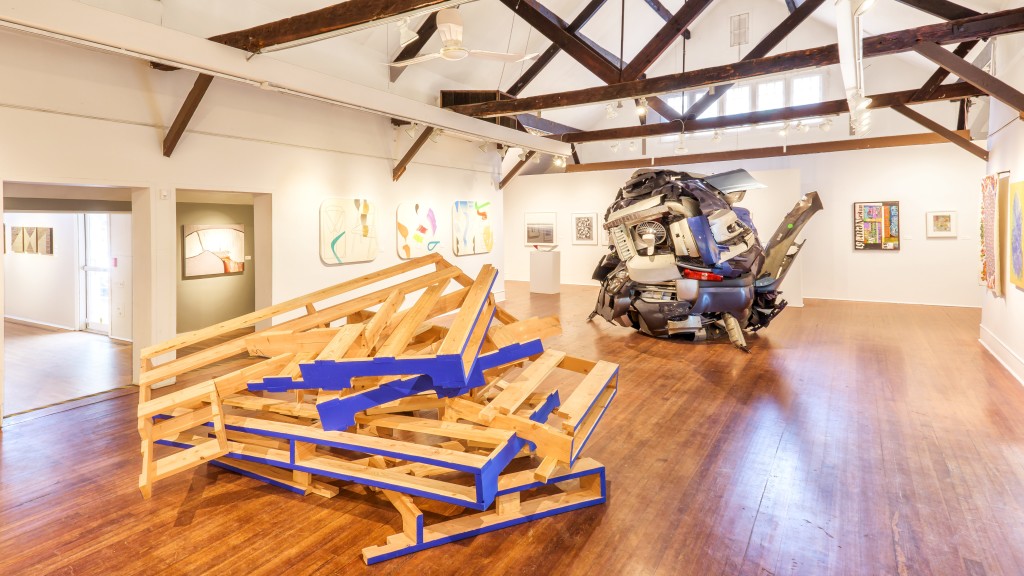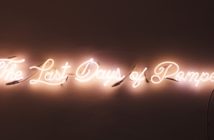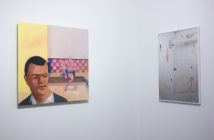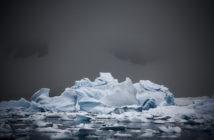In its 65th year, Art of the Northeast, on view through July 26th at Silvermine Arts Center, is unplugged. Out of the eighty-five works in the show, none are new media. Forty-two works are paintings, eleven are prints, six are drawings, three are ceramic vessels, three incorporate fabric/textiles, and one is a porcelain sculpture. Overall, the selected objects both possess a strong physical presence, and reference the history of modern art and design. This focus on materiality hones in on the sensibilities of the show’s co-jurors, Michelle Grabner and Brad Killam.
Grabner and Killam are known for being “pro artist and anti curator” and “not driven by commercial interests.” These descriptions are from the website of The Suburban, a forward-thinking artist residency that the husband-and-wife team founded in the late 1990s in the back yard of their suburban home in Oak Park, Illinois. The initial space was humble, just 8x8 feet in size, independent and artist-run. Over the last fifteen years, Grabner and Killam have exhibited work by over 200 artists based on a commitment to support the realization of artists’ radical ideas. Since 2008, the couple have expanded to an 8,000 square foot project space at the Waupaca County Poor Farm in Wisconsin, dedicated to year-long exhibitions.
Grabner has gained notoriety since curating the fourth floor of the Whitney Biennial in 2014. Her colorful selections included hundred pound ceramic and porcelain sculptures, textile works, and paintings by several well known female artists, including Jacqueline Humphries and Amy Sillman, which she placed amongst works by lesser-known female artists, including Sheila Hicks, and Shio Kusaka. Out of fifty-three artists for the Biennial, five of her selections were past students, and several were Suburban alumni, illuminating her commitment to cultivating lasting relationship with collaborators.
Silvermine Gallery Director, Jeffrey Mueller, was drawn to Grabner and Killam’s artist-centricity, which mirrors Silvermine’s operating model and founding philosophy. In 1908, sculptor Solon Borglum established the rural region as an alternative place for artists to gather. Fourteen years later, twelve artist-residents formed a Guild. In 1924, the establishment of the Silvermine School of Art followed, attracting the likes of Milton Avery, Helen Frankenthaler, and Merce Cunningham, who took positions as teachers.
While Grabner and Killam “didn’t know a lot about Silvermine before participating in the show”, they recognized the list of founding artists, and reputable curators who had juried the Art of the Northeast in the past. Similarly, the pair was unfamiliar with the majority of the applicants. “This aspect of the show being democratic is important,” Mueller explained. “It’s about the work more than the name of the person behind it.” To ensure that the strongest work made it into the exhibition, Silvermine facilitated a two-part review process, which involved bringing the Grabner and Killam’s computer-juried selections into the gallery space, so they could assess whether each piece physically held up.
Grabner and Killam attracted artists who share their interest in the tension between fine arts and modern craft. Mueller explains, “Each year, the guest juror defines the show,” says Mueller. “Last year, Andrew Russeth was attracted to works that expressed an immediacy. In 2013, David Ross selected a lot of new media pieces. This year the works make you really stop…and think through just how they were produced. Production is an integral part of the work.”
Joan Zagrobelny’s ceramic vessels from the Abundance Series exemplify Mueller’s point. They are masterful objects, hand built with coils. Their size (roughly that of the female torso) is impossibly smooth, and their refined finish recalls the work of Ken Price. In contrast to the messy clay pieces that dominated New York’s Frieze Art Fair this year, the work demonstrates restraint, control and an intuitive process that the artist describes on her website as “paying attention and following where the clay wants me to go.” A lively tension arises between the potential for machine perfection and the introduction of human irregularity through touch.
Two oil paintings by Ashley Norwood Cooper similarly reference the human body and touch. In Talking to Afghanistan, Cooper casts the viewer into a first person perspective that overlooks a woman’s chest and body lounging in bed. The woman touches the upper lip of a man whose face appears on an iPad she’s holding. Modern influences abound: a dog’s head juts in from the canvas’s right side in the style of Marc Chagall, the bedroom is aglow with saturated colors reminiscent of Pierre Bonnard, and the concerned face on the iPad, which gazes back at the viewer, recalls the conceptual moment in Édouard Manet’s Olympia. The work is lonely and sad, referencing the Modernist paradigm that painted pictures are mere illusions, not windows into the world. But for Grabner, the iPad’s screen holds different possibilities for escape than a traditional painting. During the Curator Talk, she described how the digital screen could be entered as a portal for travel to different spaces, or as a platform for recording. In Cooper’s second painting, two bedmates fondle their iPads instead of one another. The figure on the right draws the leg of the figure on the left. Passively engrossed in the technology of touch, the show begins to build a shared interest in the relationship of the human body to technology and the history of art.
Anna Chupa’s White Quilt participates in this exploration. What appears to be a traditional quilt made by freehand in-the-ditch stitching techniques is actually computer-made. Chupa made the quilt with a longarm computerized quilting machine, which allows the piecing of the tiles to be done in individual layers in Photoshop. Her quilts typically incorporate six hundred or more tiles, and are inspired by Islamic architectural ornaments, the majority of which are photographs of plant details extracted from their backgrounds. The patterns are derived from vernacular shrines and pilgrimage sites. Just as a handmade quilt puckers at each seam, this computer-made quilt is full of density and depth. In what could be read as an homage to Anni Albers and her contemporaries at The Bauhaus, the work honors high performance quilting as it relates to efficiency, scale, and practical design.
Other notable works in the show include a mixed media work by Russel Mason, which is half painting and half print, Leah Caroline’s spooky photograph Arrangements Oak Goals, which manipulate photographs of plant life, and Jacob Zurilla’s technically mature acrylic and ink paintings.
In a show that takes regionalism as its premise, it is nearly impossible not to go in search of the one work that defines the region, albeit through the filter of the Midwestern-based curators. Here, maybe it would be the tidy, thoughtful and unassuming painting by Richard Kirk Mills that depicts the profile of an unhitched hay wagon. Parked amid chartreuse plain, the platform boasts a large, empty metal cage that takes up most of the surface. The wooden grid on wheels is sincerely nostalgic for Mondrian and Hopper, and makes us slow down to admire its even brush strokes and gentle touch.
Perhaps the audience for contemporary art has reached the point where overtly “political” work and cutting edge video is gauche. Perhaps our stamina for viewing videos in an exhibition space has been exhausted. On the other hand, perhaps the 500 artists who applied this year prefer to abstract their politics, and perhaps the exclusion of video works was meant to maintain a continuity that comes with looking at a show of all physical objects. Regardless of the forces behind this year’s focus, it is evident that viewers expecting to find a comprehensive report on the state of the art being made in the greater Northeast will instead find a show with a satisfyingly specific curatorial perspective.
Quotations from Jeffrey Mueller are based on a conversation with the author on July 13, 2015.


